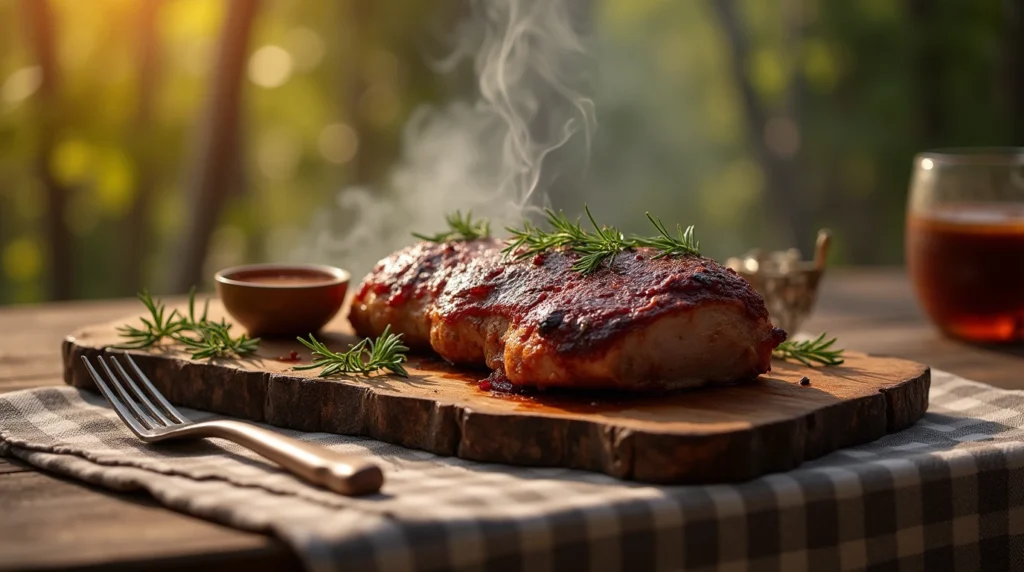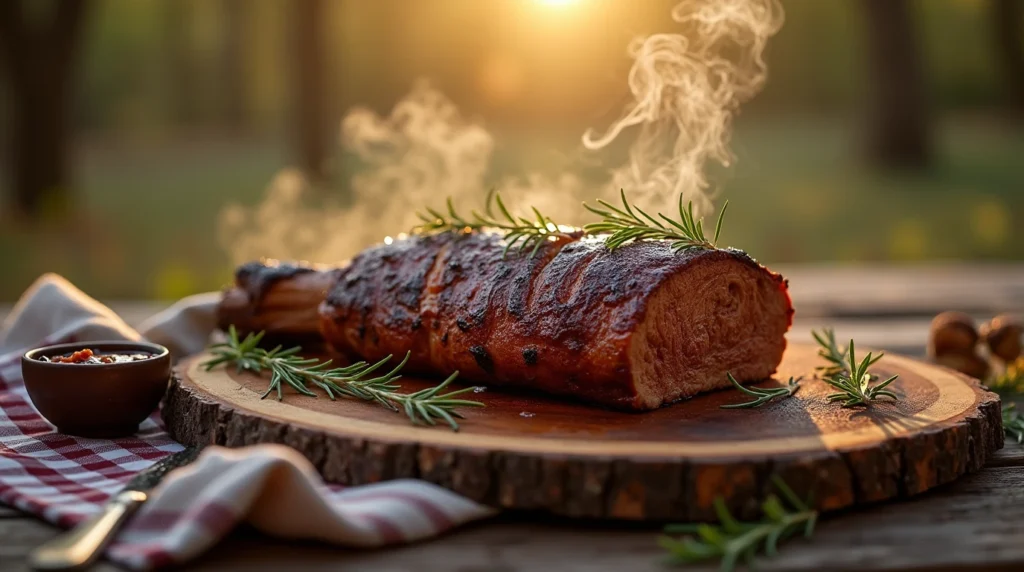Smoking a Deer Shoulder is one of the most rewarding ways to enjoy venison. The slow, steady process not only tenderizes the meat, but it also infuses it with smoky, savory flavors that are unmatched. Whether you’re an experienced smoker or trying it for the first time, smoking venison can seem like a daunting task. But fear not—by following these tips and techniques, you can achieve a mouthwatering smoked Deer Shoulder that will leave your guests asking for more. In this guide, you’ll find everything you need to know to make sure your Deer Shoulderturns out perfectly every time.
Table of Contents
Understanding the Basics of Smoking a Deer Shoulder
Before diving into the specifics, it’s important to understand why smoking a DS is such a fantastic method. The DS, while flavorful, is also a tough cut of meat. Smoking at low temperatures over an extended period of time helps break down the tough fibers and connective tissues, resulting in a tender, juicy roast. If you’re aiming for a flavorful, melt-in-your-mouth experience, smoking is the way to go.
Unlike grilling or roasting, smoking uses wood and low, consistent heat to cook the meat, which allows it to absorb the unique flavors from the wood you choose. The gradual cooking process also prevents the meat from drying out, which is a common issue with tougher cuts of meat
Essential Tools and Equipment for Smoking Venison
To achieve the perfect smoked deer shoulder, you’ll need a few key tools. Here’s a quick rundown of the essentials:

Smoker
There are several types of smokers available on the market, but the three most popular are:
- Offset Smokers: Known for their traditional, full-flavored smoke. These can be tricky to manage but provide excellent results.
- Vertical Smokers: These are easier to control and can hold a lot of meat, making them great for large cuts like a deer shoulder.
- Pellet Smokers: Known for their ease of use, pellet smokers use compressed wood pellets to produce smoke, allowing you to set and forget the temperature.
Wood Chips or Chunks
The wood you use will significantly impact the flavor of your smoked venison. Some of the best options include:
- Hickory: A strong, bold flavor that complements venison well.
- Mesquite: Known for its smoky intensity, mesquite adds a deeper flavor that works great for wild game.
- Oak: A more neutral wood, oak gives a balanced, mild smoky flavor.
- Apple or Cherry: These fruitwoods provide a subtle sweetness, which pairs wonderfully with the natural flavors of venison.
Meat Thermometer
A good digital meat thermometer is essential for monitoring the internal temperature of your deer shoulder. For a tender, juicy result, you’ll need to hit the perfect internal temperature, typically between 190°F and 205°F.
Butcher Paper
Butcher paper is useful for wrapping the meat during the smoking process. It helps retain moisture, allowing the shoulder to stay tender without losing that crispy outer bark.
Preparing the Deer Shoulder for Smoking
The preparation is just as crucial as the smoking process itself. By properly prepping your deer shoulder, you ensure that it absorbs all the flavors you intend to infuse.
Choosing the Right Cut of Meat
When selecting your deer shoulder, it’s important to choose a fresh cut, preferably one that hasn’t been frozen for too long. Look for a shoulder that has a good amount of fat. While you want to trim away excess fat before smoking, a little fat will help keep the meat moist throughout the cooking process.
Trimming the Meat
Trim any silver skin or excess fat from the DS before seasoning it. While a bit of fat is necessary for flavor, too much can cause flare-ups in the smoker or result in greasy meat. Be careful not to trim too much, as a thin layer of fat will help protect the meat during the long cooking time.
Marinating and Seasoning Your Deer Shoulder
Marinating or dry rubbing your DS is crucial to imparting flavor. You can either marinate the meat overnight or apply a dry rub right before you start smoking.
- Dry Rub: This is a simple mix of seasonings that enhances the natural flavor of the meat. A basic rub includes salt, pepper, garlic powder, onion powder, and smoked paprika. You can also add other spices like cayenne pepper or cumin to give the rub more heat or depth.
- Marinade: A marinade will penetrate the meat more deeply than a dry rub. You can create a marinade using a base of olive oil, soy sauce, and vinegar, with added spices and herbs like thyme, rosemary, garlic, and brown sugar.
Tip: Allow the meat to rest at room temperature for 30 minutes before placing it in the smoker. This helps it cook more evenly.

Table: Example of a Simple Venison Marinade
| Ingredient | Quantity |
| Olive Oil | 1/4 cup |
| Soy Sauce | 1/4 cup |
| Brown Sugar | 2 tbsp |
| Garlic Powder | 1 tsp |
| Smoked Paprika | 1 tsp |
| Black Pepper | 1 tsp |
The Perfect Smoking Technique for Deer Shoulder
Once your deer shoulder is prepped, it’s time to move on to the smoking process. The key here is to maintain a low and slow cooking method that ensures your meat is tender and flavorful.
Ideal Smoking Temperature
The perfect smoking temperature for deer shoulder is between 225°F and 250°F. The low temperature allows the meat to cook slowly, breaking down the connective tissues without drying out. Maintaining a consistent temperature is crucial for even cooking and tender results.
Smoking Time for Deer Shoulder
The smoking time will vary depending on the size of your deer shoulder. On average, it will take anywhere from 4 to 6 hours for a shoulder weighing 4-6 pounds. However, the most important factor is the internal temperature.
Target Internal Temperature
To achieve tender, pull-apart meat, you want to cook the deer shoulder until it reaches an internal temperature of 190°F to 205°F. This ensures that the collagen and connective tissues have broken down enough for the meat to be tender. Once the meat reaches this temperature, it’s ready to be removed from the smoker.
Tip: Use a digital thermometer to monitor the internal temperature throughout the cooking process.
Spritzing the Meat
During the smoking process, consider spritzing your deer shoulder with a liquid every hour to help maintain moisture. A mixture of apple cider vinegar and water or beef broth works well to keep the meat juicy without overpowering the natural flavors.
Common Mistakes to Avoid When Smoking Deer Shoulder
Even seasoned smokers can make mistakes. Here are some common errors to avoid:
Mistake #1: Not Preparing the Meat Properly
The preparation process is essential to ensuring your deer shoulder is flavorful and tender. Skipping the trimming or seasoning process can result in a bland or tough roast.
Mistake #2: Overcooking or Undercooking the Meat
Using a meat thermometer is the best way to ensure that your deer shoulder is perfectly cooked. Cooking it too long can dry out the meat, while undercooking it will leave the meat tough.
Mistake #3: Using Too Much Smoke
Over-smoking can lead to a bitter, overwhelming flavor. You want the smoke to complement the meat, not overpower it. Make sure to use moderate amounts of wood chips, and allow the smoke to circulate evenly.
Serving Suggestions for Smoked Deer Shoulder
Once your deer shoulder is done smoking, it’s time to serve it up. Here are a few ideas to make your meal even more delicious:
Side Dishes
Pair your smoked venison with sides that complement its rich, smoky flavor. Some great options include:
- Roasted Vegetables: Carrots, potatoes, and Brussels sprouts are a perfect side for smoked venison.
- Grilled Corn: Sweet corn on the cob adds a nice contrast to the smoky meat.
- Mashed Potatoes: Creamy mashed potatoes are always a crowd-pleaser and balance the richness of the deer shoulder.
Sauces
Smoked venison is delicious on its own, but a flavorful sauce can elevate the dish. Try serving with:
- BBQ Sauce: A tangy, smoky BBQ sauce is always a great match.
- Roasted Vegetables: Made with the drippings from the meat, this gravy adds extra flavor and richness.
Frequently Asked Questions (FAQs)
What’s the best wood to use when smoking deer shoulder?
Hickory and mesquite are great choices for a bold, smoky flavor. However, fruitwoods like apple or cherry can provide a milder, sweeter taste.
Can I smoke a deer shoulder on a gas grill?
Yes, you can. Make sure to set up indirect heat by placing the meat away from the direct flame and using a smoker box for wood chips.
How do I know when my deer shoulder is done?
Check the internal temperature with a meat thermometer. When it hits 190°F to 205°F, the meat will be perfectly tender and ready to serve.
Can I freeze leftover smoked deer shoulder?
Absolutely! Smoked deer shoulder can be stored in the freezer for up to 3 months. Just make sure to wrap it tightly in foil or freezer paper.
Conclusion
Smoking a deer shoulder may seem intimidating at first, but with the right preparation and technique, you can create a truly impressive dish. By using the tips and tricks outlined in this guide, you’ll ensure that your deer shoulder is tender, juicy, and packed with flavor. Whether you’re a seasoned pro or a first-time smoker, these tips will help you master the art of smoking venison. So, fire up that smoker, grab your favorite wood chips, and get ready to enjoy the best smoked deer shoulder you’ve ever tasted!
Ready to smoke your own venison shoulder? Fire up the smoker and put these tips to work for a mouthwatering meal that will impress everyone around the table.
Tell us what you think
There are no reviews yet. Be the first one to write one.


2 thoughts on “How to Smoke a Deer Shoulder to Perfection: Expert Tips for Tender, Flavorful Meat”